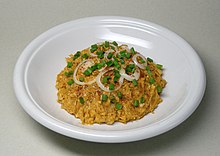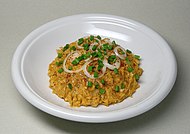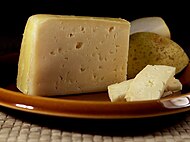List of German cheeses

Cheeses have played a significant role in German cuisine, both historically and in contemporary times. Cheeses are incorporated in the preparation of various dishes in German cuisine.[1] Germany's cheese production comprises approximately one-third of the total for all European-produced cheeses.[1]
German cheeses

A
- Allgäuer
- Allgäuer
- Altenburger Ziegenkäse – a soft cheese from cow's milk and goat's milk with caraway seeds in the cheese dough. The surface is covered with white Camembert mould. Because of its protected designation of origin, the cheese may only be produced in the districts of Altenburger Land, Burgenland and Leipzig and the independent city of Gera.
B


- Backstein – similar to Limburger, it is processed in a brick shape.[4]
- Bergader - similar to Italian Gorgonzola or French Roquefort.
- Bonifaz – a soft, white mold cheese.[5][6][7]
- Germanic Europe, and occasionally seen throughout the rest of the world.
C
- Cambozola – patented and industrially produced for the world market by large German company Champignon in the 1970s. The cheese was invented circa 1900 and is still produced by Champignon. In English-speaking countries, Cambozola is often marketed as Blue brie. It is a “hybrid” of Camembert and Gorgonzola cheeses, hence the name.
E
- Edelpilzkäse – Edelpilzkäse is a fine blue-veined cheese with a pale ivory paste. It is similar to Roquefort, but milder because it is made with cow's milk. Edelpilzkäse is made by mixing cow's milk with Penicillium spores. The mold grows within the cheese, giving the cheese the internal blue veining traveling vertically throughout and a tangy flavor. It is available in 45%, 50%, and 60% fat level.
H
- sour milk cheese (similar to Harzer) and is a culinary speciality of Frankfurt am Main, Offenbach am Main, Darmstadt, Langen and all other parts of southern Hesse. It gets its name from the traditional way of producing it: forming it with one's own hands.[8]
- curd cheese, which contains only about one percent fat and originates in the Harz mountain region south of Braunschweig.
- Hirtenkäse – or "herder's cheese", is a distinctive golden-colored, hard cow's milk cheese made in the Allgäu area of Southern Germany.[9][10][11][12]
- Hohenheim – a soft cheese, produced in a round form.[13]
K
- Kochkäse – a runny sour milk cheese similar to French Cancoillotte. It is made from quark, butter, soda, salt and caraway seeds.
L

- Limburger – originally created in Belgium by Trappist monks, production began in Germany in the 19th century.[1]
M
- cheese mites. Historically, the cheese was produced in the Saxony-Anhalt/Thuringia border region of Zeitz and Altenburg districts; today it is produced exclusively in the village of Würchwitz, in the state of Saxony-Anhalt. Mites clinging to the cheese rind are consumed along with the cheese.
- Milkana – processed cheese
-
Aged Milbenkäse
N
- sour milk cheese made in and named after Nieheim, a town in Höxter district in North Rhine-Westphalia, Germany.[14]
O
- Camembert (Romadur or similar cheeses may be used as well) and one third butter.
Q

- Quark - a fresh, mild cheese[citation needed], in Germany, quark is sold in small plastic tubs and usually comes in three different varieties, Magerquark (lean quark, virtually fat-free), "regular" quark (20% fat in dry mass) and Sahnequark (creamy quark, 40% fat in dry mass) with added cream. In addition to that, quark is sold lightly sweetened with a variety of fruits as a dessert (similar to yoghurt).
R
- entrepreneurBasil Weixler.
- Romadur – This is a cow's milk cheese with pungent flavor.[16] It is one of the most popular cheeses in Germany.[16]
S
- pretzels, accompanying regional wine. It is classically made of cream cheese and quark, and seasoned with salt, pepper and paprika. It is somewhat similar to Obatzda.
T
- valley.
W
Weißlacker, with paprika
- Weißlacker – (German for "whitewashed" due to the rind color) or Beer cheese is a type of cow's milk cheese that originated in Germany, but is now known worldwide. It is a pungent and salted surface-ripened cheese that starts out much like brick cheese.
Z
- Ziegel – prepared from cow's milk.[18]
-
A plate of Obatzda, garnished with white and green onion
See also
References
- ^ ISBN 978-1-59257-714-9. Retrieved 29 December 2019.
- ISBN 0062011553
- ^ https://www.cheese.com/allgauer-emmentaler/
- ^ German Cooking: Five Generations of Family Recipes - Eleanor A. Hinsch. p .10.
- ^ Country Life
- ^ Eating Your Words: 2000 Words to Tease Your Taste Buds
- ^ The Friends of Wine
- ^ Food Dictionary: handkäse cheese
- ^ Fond o'Foods website Archived 2011-07-11 at the Wayback Machine. Accessed March 17, 2009.
- ^ Janet Fletcher, "Cheese Course: Hirtenkäse fans party when the cows come home," San Francisco Chronicle, February SF Gate website. Accessed March 17, 2009.
- ^ German Deli site Archived 2009-08-16 at the Wayback Machine. Accessed March 17, 2009.
- ^ Barbara Adams, "Cheese and Wine Pairing Recipe: Hirtenkäse Cheese and Gewürztraminer Wine," found at Barbara Adams' Beyond Wonderful website Archived 2008-12-01 at the Wayback Machine. Accessed March 17, 2009.
- ^ German Cooking: Five Generations of Family Recipes - Eleanor A. Hinsch. p. 16.
- ^ United States Department of Agriculture (1949). Agriculture Handbook. U.S. Department of Agriculture. p. 84. Retrieved 8 April 2021.
- ^ a b Encyclopedia of Cheese, igourmet.com
- ^ a b Cheese For Dummies – Culture Magazine
- ^ Fox, Patrick. Cheese: Chemistry, Physics and Microbiology. p. 200.
- ^ German Cooking: Five Generations of Family Recipes - Eleanor A. Hinsch. p. 24.






